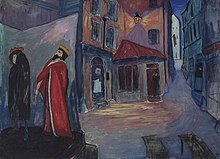Summer stage

|
| Summer stage |
|---|
| Marianne von Werefkin , 1910 |
| Tempera on cardboard |
| 56 × 73 cm |
| Fondazione Marianne Werefkin , Museo comunale d'arte, Ascona |
Summer stage is the title of a painting that the Russian artist Marianne von Werefkin painted in Lithuania before Easter in 1910 at the latest when she was in Kovnov . The work belongs to the holdings of the Fondazione Marianne Werefkin (FMW) in Ascona . There it has the inventory number FMW-0-0-23.
Technology and dimensions
It is a tempera painting on cardboard , 56 × 73 cm.
iconography
The title already says the essence of the representation: under the night sky in an open area there is an elaborate, roofed, brightly lit open-air stage with various curtains. In front of it you can see the orchestra pit with musicians, which is located in the open air. Then to the left at the lower edge of the picture follow the first two rows with spectators sitting close together. Side of the stage and the spectator area behind a wooden fence also huddled together a large number of onlookers .
Werefkin's parody
The audience seems to have come to see the performance of a popular dancer. Compared to the audience, Werefkin painted the male figure on stage larger than life. It is a Cossack who dances the kazachok . He is dressed in a black coat. Underneath he wears a red Kosovorotka , with a belt of the same color over his dark blue trousers. High boots and a strange, feather-adorned cap complete its presentation. With a light blue cloth in hand, he will wave to the audience with applause .
The representation was created by the painter as a satirical , because the "Cossack Dance" is usually danced by athletic, slim people and is characterized by many artistic interludes . Werefkin, who comes from an old Cossack family on her mother's side, certainly knew very well how the kazachok was presented in Russia . Here in Lithuania , in the province of the Russian Empire, in the Kovno Governorate , a corpulent actor with an awkward pose appeared, who is not really believed to be able to turn in circles with high jumps, nor to be able to keep his legs drawn up close Skilfully dance floor. Werefkin must have found his appearance to be a rather clumsy spectacle , because it portrays the clumsily stomping and kicking actor and the entire bizarre situation, in the style of Toulouse-Lautrec , exaggerated as a caricature . The audience, frozen in amazement, fits in with this.
Bizarre movements
Werefkin included the stylistic devices of cloisonism . One also feels reminded of pictures of the Nabis , which show figures in strangely bizarre movements. These in turn drew from the Japanese art of woodcut , which had created a type of image that particularly likes to show actors in fantastic appearances in a grotesque posture with comical gestures. Since it is precisely this type of image that has been preserved in several copies in Werefkins and Jawlensky's joint Japanese woodcut collection, it can be assumed that Werefkin was not only inspired by the Nabis to adopt it, but also, like them, directly resorted to original Japanese models when they came to the painting “Sommerbühne” , the counterpart to Into the night worked.
literature
- Clemens Weiler : Marianne von Werefkin. In exh. Cat .: Marianne Werefkin 1860–1938. Municipal Museum Wiesbaden 1958, cat.no. 30, undated (p. 10)
- Bernd Fäthke: Marianne Werefkin. Munich 2001, p. 155, fig. 175, ISBN 3-7774-9040-7
- Bernd Fäthke : Marianne Werefkin: Clemens Weiler's Legacy. In: Marianne Werefkin and the Women Artists in her Circle. (Tanja Malycheva and Isabel Wünsche eds.), Leiden / Boston 2016 (English), pp. 8–19, ISBN 978-9-0043-2897-6
Individual evidence
- ↑ The painting was first published by: Clemens Weiler: Marianne von Werefkin. In exh. Cat .: Marianne Werefkin 1860–1938. Municipal Museum Wiesbaden 1958, cat.no.33, undated (p. 10)
- ^ Meyers: Large conversation lexicon. A reference book of general knowledge. Leipzig and Vienna 1907, vol. 11, p. 521, "Cossacks (Russian Kasák, plural Kasakí) [...] The word is of Turkish-Tatar origin and means in Turkish a mugger, Tatar a free warrior."
- ↑ This is referred to by her maiden name Daragan, a Russified word which means “wheat prince” in translation. Under Tsar Peter the Great , their ancestors had been given the task of protecting the Russian border in the south of the empire against Caucasian mountain tribes . See: Bernd Fäthke: Marianne Werefkin. Munich 2001, p. 14, ISBN 3-7774-9040-7
- ↑ Ursula Perucchi-Petri: The landscape of the big cities, streets, squares and public parks. In exh. Cat .: The Nabis. Prophets of modernity. Exhib. Cat .: Kunsthaus, Zurich 1993, p. 77 ff.
- ↑ Ildikó small Bednay: Jawlensky Japanese woodcut collection. In exh. Cat .: Jawlensky's Japanese woodcut collection. A fairytale discovery. Edition of the Administration of State Palaces and Gardens, Bad Homburg vdH, No. 2, 1992, pp. 87 ff.
- ↑ Exhib. Cat .: Jawlensky's Japanese woodcut collection. A fairytale discovery, edition by the Administration of State Palaces and Gardens, Bad Homburg vdH, No. 2, 1992. Plates 9, 11, 20.
- ↑ Bernd Fäthke: Von Werefkins and Jawlensky's weakness for Japanese art. In: exhib. Cat .: "... the tender, spirited fantasies ...", the painters of the "Blue Rider" and Japan. Murnau Castle Museum 2011, p. 119 f, Fig. 33–34.
